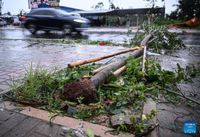Typhoon Matmo, the 21st typhoon of the year, has carved a destructive path across southern China and into Vietnam, forcing mass evacuations, shutting down cities, and unleashing relentless rain and wind that have left communities reeling from its impact. As the storm’s effects continue to ripple through the region, the scale of the disruption—and the resilience of those affected—has come into sharp focus.
On October 4, 2025, Matmo re-intensified into a typhoon as it departed the Philippines and set its sights on China’s Hainan province, according to China’s National Meteorological Center. With sustained wind speeds of 118 kph (73 mph) that morning, the typhoon was expected to strengthen further before making landfall in Guangdong and Hainan provinces the following day. The anticipation of Matmo’s arrival triggered a flurry of urgent preparations. Haikou, the capital of Hainan, announced the cancellation of all flights from 11 p.m. that night, suspended public transport, shut businesses, and closed schools. Train routes across Hainan were cancelled, with further suspensions planned as the storm approached. The national weather observatory issued an orange alert, the second-highest warning level, underscoring the seriousness of the threat.
By midday on October 5, Typhoon Matmo made landfall between Wuchuan in Guangdong and Wenchang in Hainan, packing maximum sustained winds of 151 km per hour (94 mph) and moving northwest at about 25 km per hour (15 mph), as reported by the South China Morning Post. The storm’s approach prompted the evacuation of nearly 347,000 people from high-risk and coastal areas in Guangdong and Hainan. Over 10,000 emergency and rescue personnel were deployed across Guangdong, with provincial deputy party secretary Meng Fanli urging officials to “swiftly go into battle mode” to ensure “no casualties and minimal losses” during the busy National Day and Mid-Autumn holidays.
Entire cities braced for impact. Zhanjiang, a major port city, imposed a full shutdown of classes, businesses, transport, and public services from Saturday night, closing all highways from Sunday morning. Similar closures were enacted in Haikou and Wenchang, where schools, workplaces, ferry routes, and scenic spots were temporarily closed. All trains on Hainan Island were suspended on Sunday, with high-speed rail services expected to resume the next day. Flights to and from Haikou Meilan International Airport were cancelled from Saturday evening, with a gradual resumption anticipated later on Sunday. Hong Kong, too, was affected, with more than 100 flights expected to be disrupted and up to 27 cancellations forecast. The Hong Kong Observatory announced that the storm was weakening and would gradually move away during the day, though it warned that “there will be occasional squally showers, thunderstorms and intense gusts.”
As Matmo moved inland, its effects were far from over. Authorities warned of heavy rainfall—up to 249 mm (9.8 inches) in some areas—raising the risk of flooding and landslides as the storm tracked toward China’s Yunnan province and northern Vietnam. On October 6, Matmo struck the Guangxi Zhuang Autonomous Region in southern China for the second time, bringing strong winds and heavy rain to the coastal cities of Beihai, Qinzhou, and Fangchenggang. According to Xinhua News, by 11:00 a.m., the typhoon had affected 10,561 people in Beihai, displacing 10,003 and damaging 3,400 hectares of crops. Over 4,000 trees were toppled in Beihai, blocking roads and prompting a rapid response from city officials, who dispatched personnel to clear debris and restore traffic. In Qinzhou and Fangchenggang, emergency teams tackled fallen trees and billboards, while efforts to address standing water continued.
Recovery in Beihai was a massive undertaking, involving more than 1,300 personnel, 116 emergency vehicles, and 1,730 generators. The Red Cross of China launched an emergency response, distributing 3,400 aid packages to those affected. Meanwhile, the cities of Chongzuo and Qinzhou began lifting traffic restrictions and gradually restoring railway services as the storm moved on.
As Matmo advanced toward northeastern Vietnam on the afternoon of October 6, its outer bands brought further misery. On October 7, heavy rain triggered by the typhoon flooded parts of Hanoi, Vietnam’s capital, with water reaching up to calf height, as reported by the Straits Times. Main roads became impassable, stranding cars and motorcycles and forcing residents to wade through flooded streets. Central districts were hit particularly hard, with drainage systems struggling to keep up. “It’s a loop – rains come, streets flood and people desperately try to get by,” said Hanoi resident Nguyen Ngoc Long. “I fear this will soon become a norm for us.”
Several schools in Hanoi closed or shifted to online learning, and flights to and from Noi Bai International Airport faced delays and rescheduling. The Meteorological Agency warned of continued rain and thunderstorms throughout the morning, especially in low-lying areas, and predicted at least three more storms could hit Vietnam before the end of the year. The sense of déjà vu was palpable for many families who had just finished cleaning up from Typhoon Bualoi, which had killed at least 51 people in Vietnam and caused an estimated $600 million in damages only a week earlier.
Throughout the ordeal, local and national authorities coordinated to minimize casualties and damage. In China, officials emphasized the need for strict enforcement of evacuation orders and rapid deployment of emergency resources. The Red Cross and other aid organizations mobilized quickly, delivering essential supplies to the hardest-hit regions. In Vietnam, the focus turned to ensuring public safety and restoring normalcy as quickly as possible, even as the forecast warned of more storms to come.
Despite the best efforts of governments and communities, the back-to-back battering by Matmo and previous storms has highlighted the growing vulnerability of the region to extreme weather events. Rapid urbanization, inadequate drainage, and the increasing intensity of storms have combined to make flooding and disruption a recurring challenge. As Nguyen Ngoc Long’s words suggest, the cycle of rain, flooding, and recovery is becoming an all-too-familiar part of life for millions.
With Typhoon Matmo now weakening as it moves further inland, the immediate danger may be passing, but the task of rebuilding—and preparing for the next storm—remains urgent. The resilience shown by those affected, and the swift mobilization of emergency services, offer hope amid the devastation, but also a stark reminder of the ongoing need for vigilance and adaptation in the face of nature’s power.





